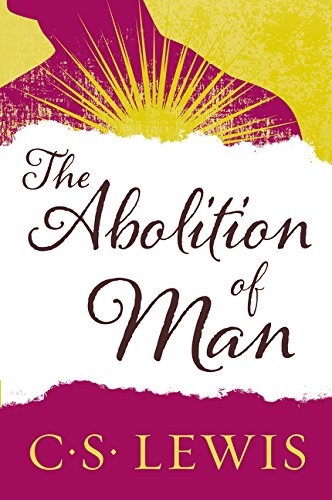A Brief Book Summary from Books At a Glance
By Steve West
Introduction
The Abolition of Man is comprised of three lectures that Lewis gave on the topic of morality. He argues that there is an objectively right way of ordering values which corresponds to reality. Lewis refers to the universal standard and system of morality as the Tao. He endeavours to show how rejecting the Tao leads to incoherence in ethics. Furthermore, he argues that getting rid of the Tao can result in the actual abolition of man (i.e. the kind of beings that we really are would be eradicated and replaced with something else).
Table of Contents
Chapter 1 Men Without Chests
Chapter 2 The Way
Chapter 3 The Abolition of Man
Appendix: Illustrations of the Tao
Summary
Chapter 1: Men Without Chests
We often fail to recognize how important the books are that elementary students read in school. There is a book that mentions Coleridge’s view that a waterfall is truly sublime. The authors of this book say that he is wrong: saying that something is sublime is a statement about our feelings, not a statement about the properties of anything external. Not to be pedantic, but our feelings are not sublime (to call something sublime doesn’t make our feeling sublime; our feelings are actually those of humility before the sublime). When we say something is contemptible, we do not mean that our feelings are contemptible. The assumption that our statements of value are really only statements of feeling is freighted with philosophy, ethics, theology, and politics. The authors downplay the proper role that historic sites and experiences can play in raising up a proper sense of moral improvement. All is reduced to mere subjective feelings, and we are to avoid being taken in by them. When contemporary authors try to make this case, they often select poor examples of writing rather than classical and superior ones. Students who read these books are getting philosophy, but not the English they are ostensibly supposed to be learning.
To help students avoid false and harmful sentiments, the right solution is to build up just and good ones. In the past, people believed there was a congruence between proper feelings and external reality. Coleridge thought it was right to call the waterfall sublime, because it merited it. Classical thinkers and educators wanted students to learn to love things as they ought to be loved. Our affections must be trained to hate or love what ought to be hated or loved. We must bring ourselves into conformity with what is good; our feelings need to correspond to reality. The Tao and the Law are held to be truth; all peoples have seen this. We will refer to this transcultural way of proper goodness as “the Tao.” There is objective value, and right and wrong attitudinal responses to it. Reason and emotion should be in harmony. The contemporary authors who challenge this view end up divorcing emotions from reasons, and thus make every emotion equally non-rational. We need reasons in order to be virtuous, since if we don’t have reasons our animal nature will overwhelm us when we are called upon to practice the harder virtues. Our reasons organize our emotions, and our emotions control our behavior. Our heads are to organize our hearts, and this is to control our stomachs. The head controls the stomach through the chest—but we are producing men without chests, and are then surprised by their behavior.
Chapter 2: The Way
If we follow some of the trends in contemporary education, it will destroy the society that accepts it. Educators may teach that values are subjective, yet they still try to inculcate values that they think will help produce a society they deem desirable. To have any goal and aim is to believe that some end is good compared to. . .
[To continue reading this summary, please see below....]The remainder of this article is premium content. Become a member to continue reading.
Already have an account? Sign In
